If you search for fermented pineapple, you won't find this fermented pineapple hot sauce in the first place, but quite a few recipes for tepache. You will find instructions at my site as well. Tepache is a traditional fermented drink from Mexico that is quite straightforward to brew and served cold, and it''s the ultimate in sustainability because tepache is made from the waste of the pineapple.
Since I ferment tepache myself, my ecological conscience is much less troubled when I eat this delicious and very healthy, but not at all local fruit. I don't waste any part of the fruit that has traveled so far. When I make fermented pineapple hot sauce, you can be sure that I'm making tepache at the same time.
You can then either eat the flesh of the pineapple, or make fermented pineapple sauerkrautfrom it, or this fruity and spicy fermented pineapple hot sauce.
INGREDIENTS
- 2/4 of a small organic pineapple, peeled and cored
- 8 orange habañeros
- 1 red habañero
- ½ big white onion
- 1 orange bell bell pepper
- 250 ml water
- 8 gr salt
- 3 tbsp. raw cane sugar
* the sugar is needed for seasoning after fermentation in around 8 weeks.
PREPARATION
Make a brine from the water and the salt. The water does not have to be warm for this, it is enough if you do this step first and stir diligently.
Chop the pineapple, bell pepper and onion randomly into larger pieces. Remove the stalks and caps from the habañeros. It may be advisable to wear gloves - depending on what else you are going to do that day...
Put everything in a suitable container and weigh it down with a weight. The weight is important because peppers and habañeros have strong buoyancy and peppers also have a tendency to mold. And although chilies can prevent mold, there are not enough of them in this ferment. For more information on weights or other ways to prevent mold at https://fermentation.love/en/fermentation/fermentation-faq/#brauche_ich_unbedingt_ein_fermentiergewicht.
The best vessel is a swing-top jar. The gases that develop during the fermentation of the fermented pineapple hot sauce can escape, but oxygen does not get in. Best conditions against mold and for success!
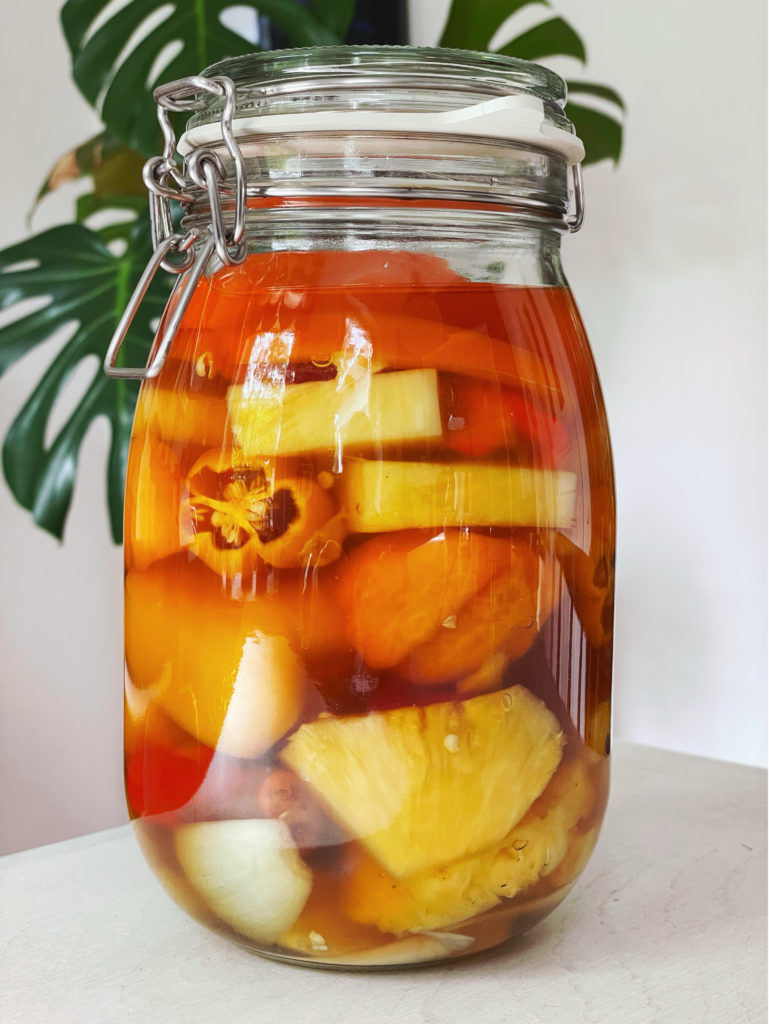
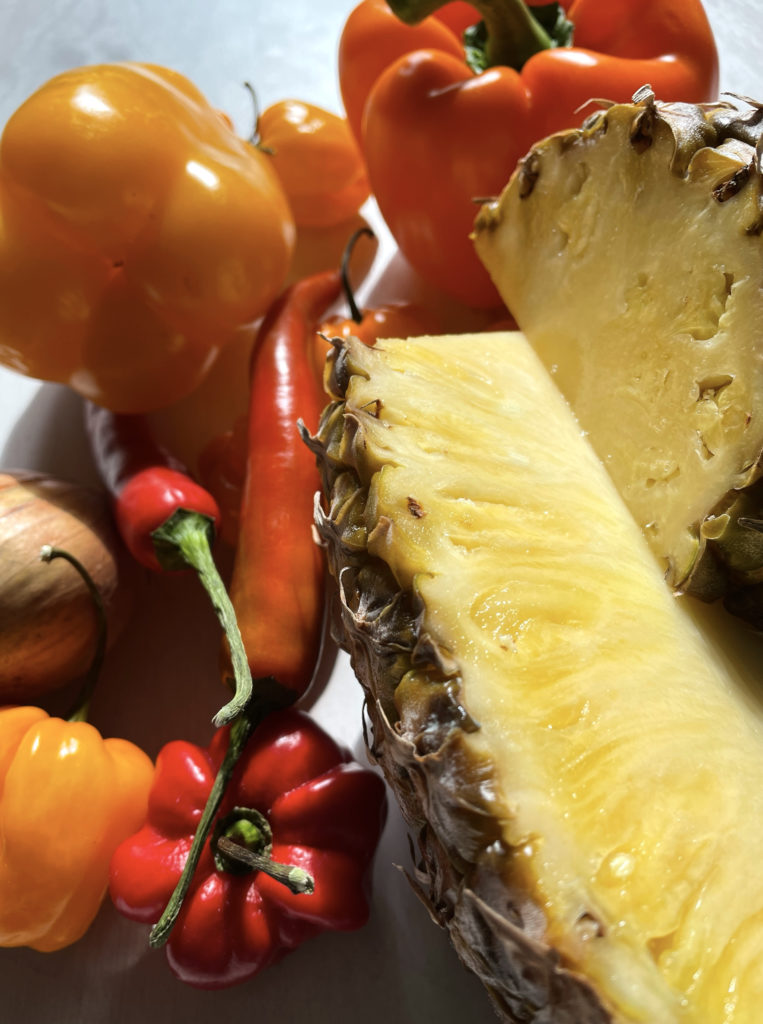
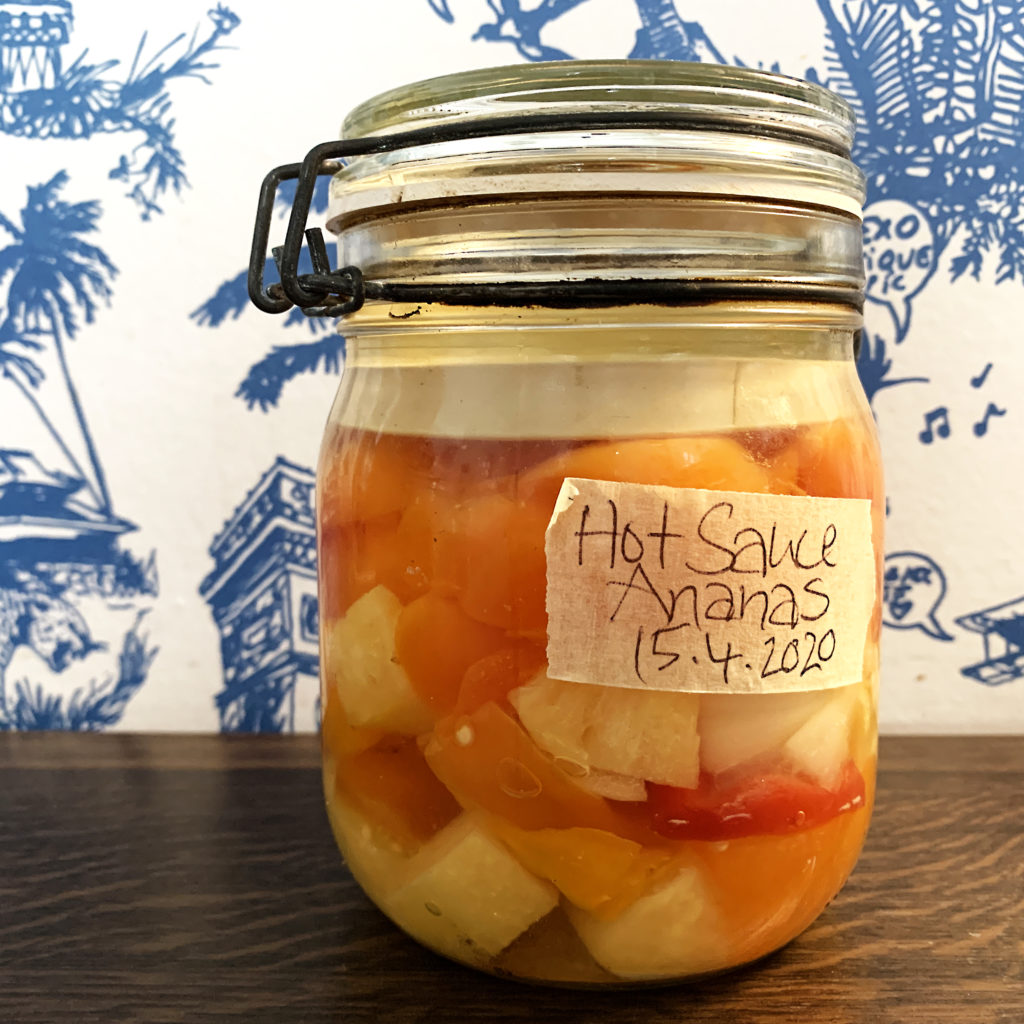
If you do not want to sterilize the sauce later, so as not to destroy the positive health effects of lactic acid fermentation, you must let it ferment for at least 8 weeks. Leave it in the warm kitchen for the first 4-5 days and observe. The yeasts on the fruit can lead to increased gas formation, in case of doubt it is better to release pressure more often. When pressing down the rubber tab, you will quickly notice how much pressure has been created inside. After 5 days, move to a cooler room. In my case, the ferments are stored in the hallway shelf at approx. 18°C.
How long should the hot sauce ferment for?
After 8 weeks the sauce is pureed. Pour off the brine and fill the rest into the food processor. In small sips, add only as much brine as necessary to create a nice, viscous consistency.
The sauce is very hot and sour. The pineapple flavor comes out well when the large pieces are pureed, but the sweetness has disappeared due to the long fermentation. I have added 3 tablespoons of raw cane sugar. This can be more or less, depending on your taste, of course.
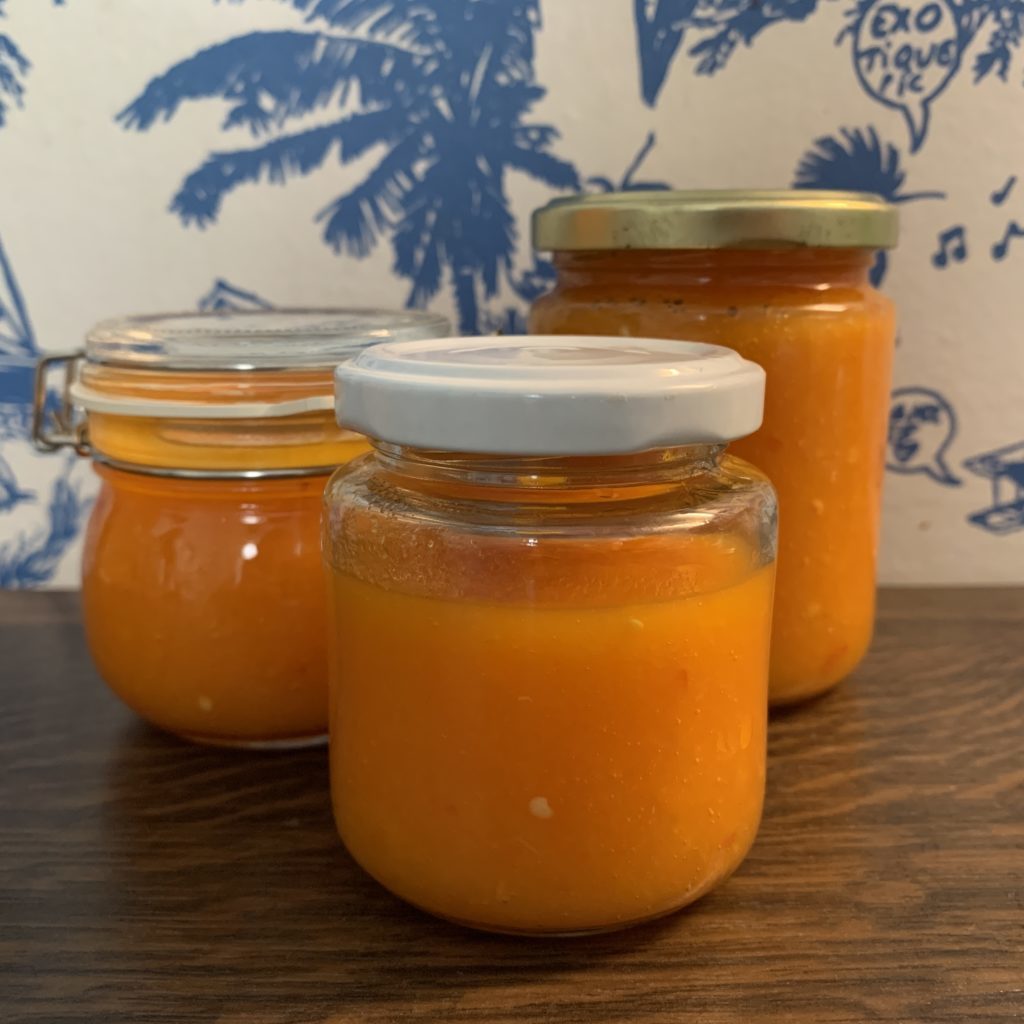

Fill the sauce into glasses and place in the refrigerator until consumed. Since the sauce is unpasteurized, do not screw the lids on tightly, it will continue to ferment silently and quietly. The full aroma unfolds after another 2-3 weeks in the refrigerator.
I keep fermented hot sauces in the refrigerator for at least 10 months.
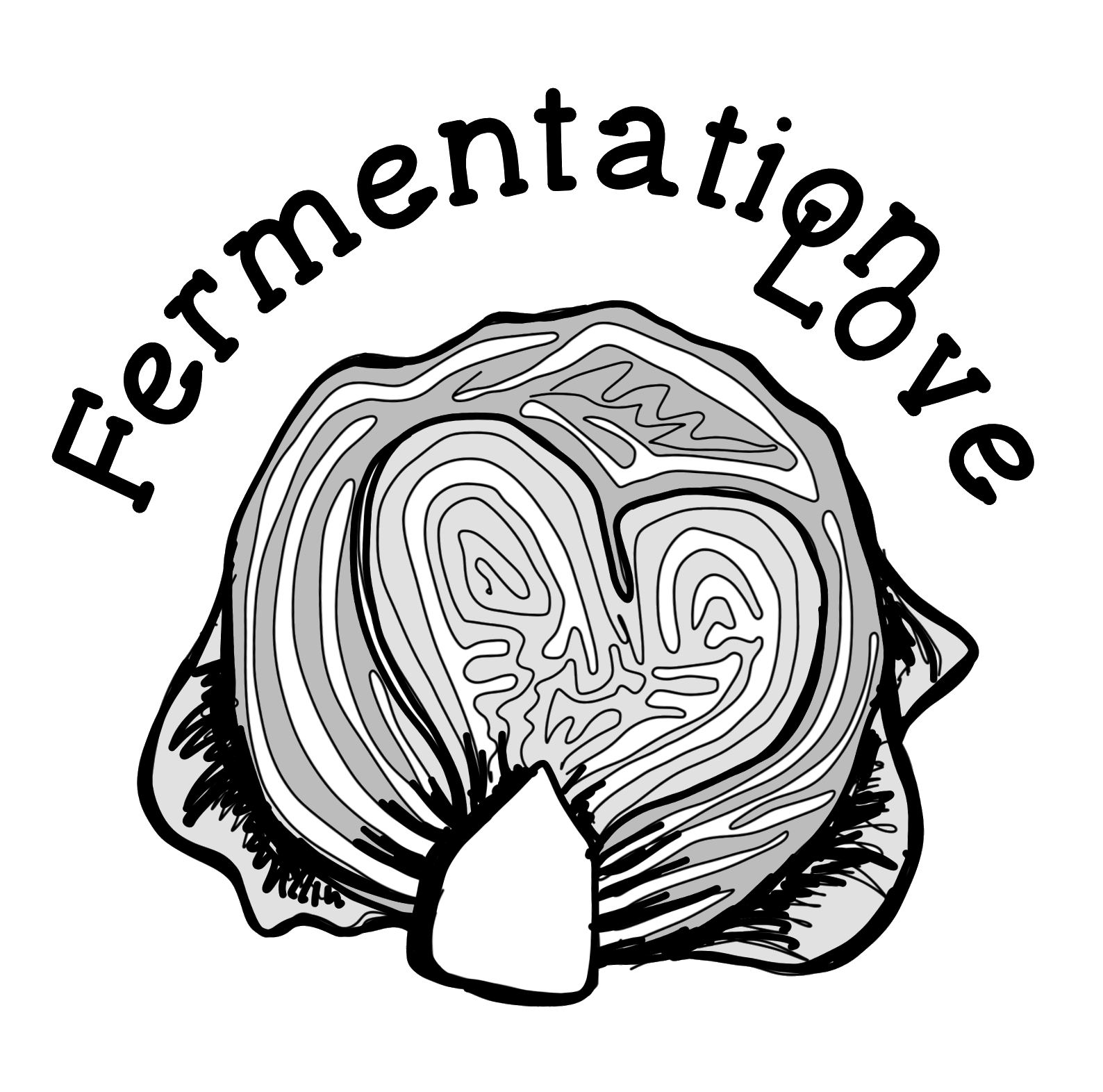
Hallo Katsu
Nachdem ich Deinen Katsulua/Kaffeelikör schon gepimpt mit 2 Thaichillies & ganz wenig Orangenschale (sehr dünn, ohne das Weisse) angesetzt habe, ist’s mir wieder passiert:
Pineapple Hot Sauce – frei Schnauze
statt am Schluss zum Pürieren +/- 3 EL Rohrohrzucker zugeben zu müssen, weil sonst sehr sauer, habe ich zum Ferment 3 El fermentierten Honigknoblauch zugesetzt. In ca. 8 Wochen weiss ich dann, ob & wie’s schmeckt….
Lieben Dank für Deine tollen Rezepte/ Anregungen hier & auf FB!
Herzlichen Gruss aus der Schweiz, Jeannette
Liebe Jeanette,
die Idee mit der Orangenschale beim Katsulua ist grossartig! Und auch die Chili kann ich mir sehr sehr gut vorstellen. Ich freue mich, dass ich Dich inspirieren kann, und danke, dass Du Deine tollen Variationen teilst.
Viel Spaß weiterhin beim Fermentieren,
Katsu
Bei den Bügelgläsern mit Gummi nehme ich an dass der Deckel nur aufgelegt aber nicht mit Druck verschlossen wird solange es sich im Anfangsstadium der Gärung befindet, weil geschrieben wird dass das Gas entweicht?
Ich kann mir von meiner Erfahrung mit Bügelflaschen nicht vorstellen dass es ganz geschlossen möglich wäre das etwas entweicht.
Ich habe von meinen Chillis in einem großen Schraubglas eine Maische angesetzt mit Salz und etwas Essig damit es gären kann. Für den Luftabschluss habe ich eine Schicht Olivenöl auf die Maische gegossen, so kann das Gas entweichen, und nach der Gärung wird das Öl entweder anderweitig verarbeitet, oder dann halt partiell mit der fermentierten Chillipaste.
Hej Gabriel,
das ist nicht korrekt. Das besondere an den Gläsern ist ja gerade der Gummiring, der das entstehende Kohlendioxid entweichen lässt, ohne, dass Sauerstoff wieder ins Glas gelangen würde. Bei einem offenen Deckel wird der Sauerstoff nicht verdrängt, so dass Kahmhefe oder Schimmel wachsen können. Lies dir gerne nochmal meine Erklärungen unter dem Menüpunkt Fermentation durch, ich habe alles sehr ausführlich erklärt.
Ich rate auch davon ab, eine Maische zu fermentieren, sie ist viel anfälliger für schädliche Bakterien. Auch von der Benutzung von Öl rate ich ab. In Öl eingeschlossenes Gemüse kann nicht durchsäuern, was aber nötig ist, um c. botulinum an der Vermehrung zu hindern. Eine Aussporung muss in jedem Fall vermieden werden. Es mag selten vorkommen, aber die Möglichkeit ist da und sollte bewusst wahrgenommen werden.
Ich hoffe, meine Erläuterungen helfen dir weiter.
Bleib gesund,
Katsu
Hallo Katsu,
habe gestern und heute fünf! Rezepte von dir umgesetzt und freue mich auf die Ergebnisse. Bei der Hot Sauce habe ich versehentlich 2%ige Lake angegossen, habe die Empfehlung 250 ml und 8 g Salz überlesen. Ich weiß nicht genau, wieviel Flüssigkeit es war, ich schätze 350 ml? Würdest du noch nachsalzen oder klappt das auch so?
Danke für deine tollen Inspirationen!
Merle
Hej Merle,
wegen des Anteils an Obst in diesem Ferment erhöhe ich den Salzgehalt. Damit schränke ich die Hefen ein, bis die milchsaure Gärung anspringt und vermeide alkoholische Noten. Wenn das Ferment erst seit gestern steht, salze heute nochmal ein bisschen nach und verschliesse das Glas danach wieder.
Gutes Gelingen!
Katsu
Hallo Katsu,
ich habe in den letzten Tagen ganze fünf Rezepte von dir umgesetzt und bin sehr gespannt auf die Ergebnisse!
Bei der Hot Sauce (gestern angesetzt) habe ich irgendwie die Mengenangabe fürs Salz überlesen und statt dessen zweiprozentige Lake angegossen – was meinst du, soll ich noch Salz hinzufügen oder passt das so? Ich hab die Lake auch nicht genau bemessen.
Außerdem habe ich gestern zwei große 2-Liter-Schraubgläser im Angebot erstanden. Wohlgemerkt keine Twist-Off-Gläser, sondern mit Gewinde (hat aber innen im Deckel so einen Gummirand wie TO). Der Unterschied war mur beim Kauf nicht so deutlich. Ich habe gestern damit Salzzitronen angesetzt. Heute schrieb jemand im Forum auf FB, dass Gewindegläser des Teufels sind und nicht funktionieren. Soll ich besser noch ein Bügelglas kaufen gehen…?
Danke für deine tausend Inspirationen, immer wieder!!
Liebe Grüße
Merle
Hej Merle,
zum Hot Sauce Ferment im vorigen Kommentar.
Nockendeckel sind geeignet, andere eher nicht. Denn wenn die Gase nicht selbständig entweichen können, musst du den Deckel immer mal wieder leicht aufdrehen, um Überdruck zu vermeiden. Ich empfehle das nicht, aber wenn du sie nunmal hast, achte darauf, nur sehr kurz Gas rauszulassen und sofort wieder zuzudrehen, damit möglichst kein Sauerstoff in das Glas gelangt. Ausserdem würde ich das Ferment in dem Fall gut bewegen, das kann gegen Schimmelbesiedelung helfen.
Gutes Gelingen!
Katsu
Danke! Ich habe jetzt die Zitronen in ein Bügelglas umgefüllt und bei der Hot Sauce noch Salz zugegeben. Hoffentlich klappt’s.
Sorry für den doppelten Kommentar, beim ersten kam irgendwie ne Fehlermeldung, ging aber wohl doch durch 😀
Liebe Grüße
Merle